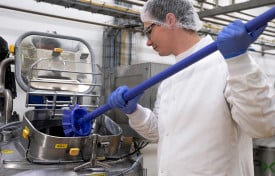An article in the April/May 2012 Food Safety Magazine entitled, “An Integrated Approach to Food Quality and Safety: A Case Study in the Cookie Industry,” brings up the possibility of food operations working with both a HACCP program and a Failure Mode and Effects Analysis (FMEA) quality management tool. In the article the authors state: “When integrated, these powerful tools can improve both quality performance and conformance within the food industry.” Though most food industry operations are familiar with HACCP, they may not be as familiar with FMEA. This may be the case, because FMEA, a part of Six Sigma, is more familiar to those in the medical field, in the auto industry, engineers, etc. As stated within the Food Safety Magazine piece, the food industry might want to consider this mode of analysis as a welcome compliment to HACCP programs in their operations.
The American Society For Quality defines FMEA as “a step-by-step approach for identifying all possible failures in a design, a manufacturing or assembly process, or a product or service.” Originally developed by the American military and used by such organizations as NASA, the process has been employed by several different industries. By anticipating the seriousness of failures, operations can address failures that are the most likely and most severe outcomes of the product production and shipping processes. These failures are ranked with a number, the Risk Priority Number (RPN), which factors in severity, frequency and detectability.
The process of determining RPNs has been a source of some debate. When faced with such doubt and concern about the accuracy and effectiveness of currently calculating RPNs, purveyors of FMEA would counter that FMEA has also been widely used and successfully implemented, becoming an industry standard. “An Integrated Approach…” argues that a successfully integrated model of HACCP and FMEA can be “used as a tool for continuous quality improvement,” where it can be repeatedly cycled “for continuing improvement toward product excellence.”
In a follow-up interview with one of the article’s authors, Marcia Hagen, an assistant professor of management at Metropolitan State University, she states, “It seems that the food industry has been focusing efforts and resources on those quality tools (like HACCP) that are government mandated, and have been slower in instituting some of the other quality tools that have been proven in other industries but have not been required in food service.” Also at play is the possible “clash between safety and quality” where companies may be “resourcing safety out of need while not resourcing quality appropriately.”
In regards to the food industry, there is not an overabundance of information specifically focusing on FMEA. This, of course, doesn’t mean that it has been successfully or unsuccessfully implemented in food industry operations. Whatever the case, the conversation about FMEA has room for growth.
Have you used FMEA along with your HACCP program? Has it been successful? What are the limitations of FMEA in your mind and how do you address those concerns in your operation? Are there any best practices you recommend? Please consider posting and discussing your experience with FMEA and what it has meant to your operation.







